With its colourful history, vibrant culture and wealth of architectural treasures, Seville beckons visitors to uncover its many layers. There are so many things to do in Seville from wandering the whitewashed streets of the Barrio Santa Cruz to visiting the world’s largest Gothic cathedral and admiring the Mudéjar courtyards of the city’s Alcázar. You should also attend a flamenco performance, visit the historic bullring and savour the best of Andalucían cuisine in Seville’s tapas bars.
Best Things to See in Seville
Seville Cathedral and La Giralda
Seville Cathedral is the largest Gothic cathedral in the world and a UNESCO World Heritage Site. It was built in the 15th century on the site of a former 12th century Almohad mosque. The cathedral’s towering dimensions, opulent decorations, treasure-filled chapels and grand tombs reflect Seville’s wealthy past. The cathedral’s most iconic component is the Giralda bell tower, which was the minaret of the former mosque. The bell tower stands 105 metres tall and visitors can climb 34 ramps to get to the top and enjoy spectacular city views from the top. Other highlights of Seville Cathedral include the glittering gold altarpiece, Christopher Columbus’ tomb and the Murillo paintings found inside.
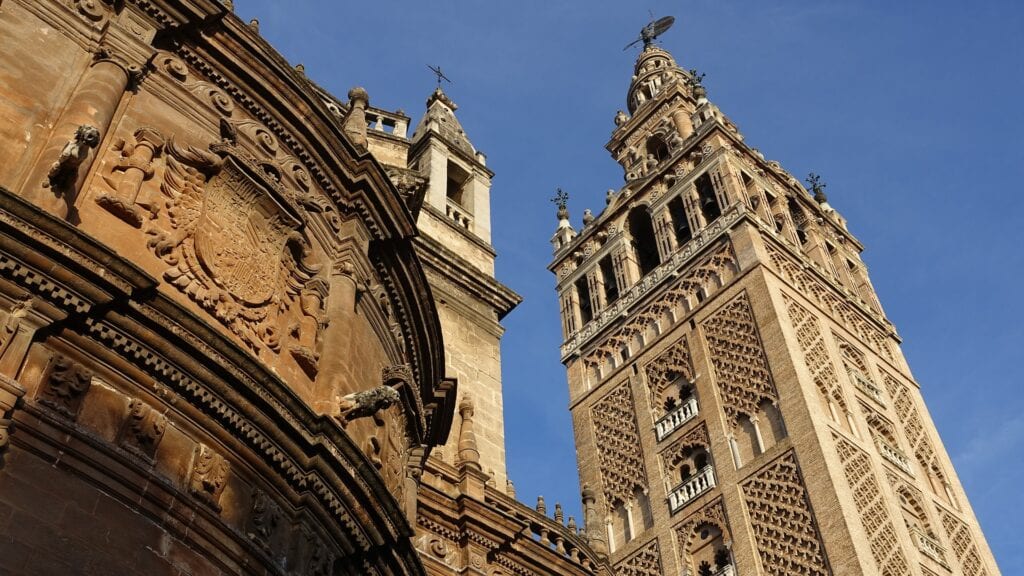
Archivo de Indias
The Archive of the Indies is a historic building that houses valuable documents relating to the Spanish Empire’s exploration and governance of the Americas. It was established in 1785 in the Casa Lonja of the merchants of Seville, a Renaissance-style building adjacent to the cathedral. The archive contains thousands of documents including maps, illustrations, letters and legislation that provide immense insight into the history of Spanish colonialism and its impact.
Some of the most prized items found here are the original petitions of the settlers of Hispanic America. This archive is a unique and incredibly important resource for studying the imperial expansion under the Spanish crown.
Alcázar of Seville
This royal palace complex displays a mixture of architectural styles reflecting centuries of Moorish and Christian history. Originally built as a fort in the 8th century, it was expanded over the centuries by Muslim and Christian rulers. Highlights include the Ambassador’s Hall with its exquisite dome and intricate tilework, the elaborately decorated Mudéjar Palace with beautiful courtyards and fountains and the lush gardens incorporating Moorish elements like geometric flower beds, pavilions and ponds.
The Alcázar is considered one of the most outstanding examples of Mudéjar architecture found anywhere in Andalucía and is recognised alongside the Cathedral and the Archivo de Indias as a World Heritage Site by UNESCO.

Barrio Santa Cruz
This charming old Jewish quarter has winding streets, picturesque squares, traditional houses with flower-decked balconies and many tapas bars and restaurants. Its is also home to the 15th century Murillo Gardens and key historical attractions such as the Hospital de la Caridad and the Hospital de los Venerables.
Plaza de España
Built for the Ibero-American Exposition of 1929 which was held in Seville, this grand plaza is probably the most impressive of all of Spain’s plazas. It features a huge semi-circular brick building decorated with azulejo tilework depicting maps and scenes from each Spanish province. In the centre of the plaza is a large fountain and moat.
The four footbridges which cross the moat represent the ancient Spanish kingdoms of Castile, Navarre, Aragón and León. Movie fans may find that the Plaza de España seems familiar as it has appeared in films such as Lawrence of Arabia and Star Wars. Visitors can rent boats to paddle along the moat for unique views of the plaza.
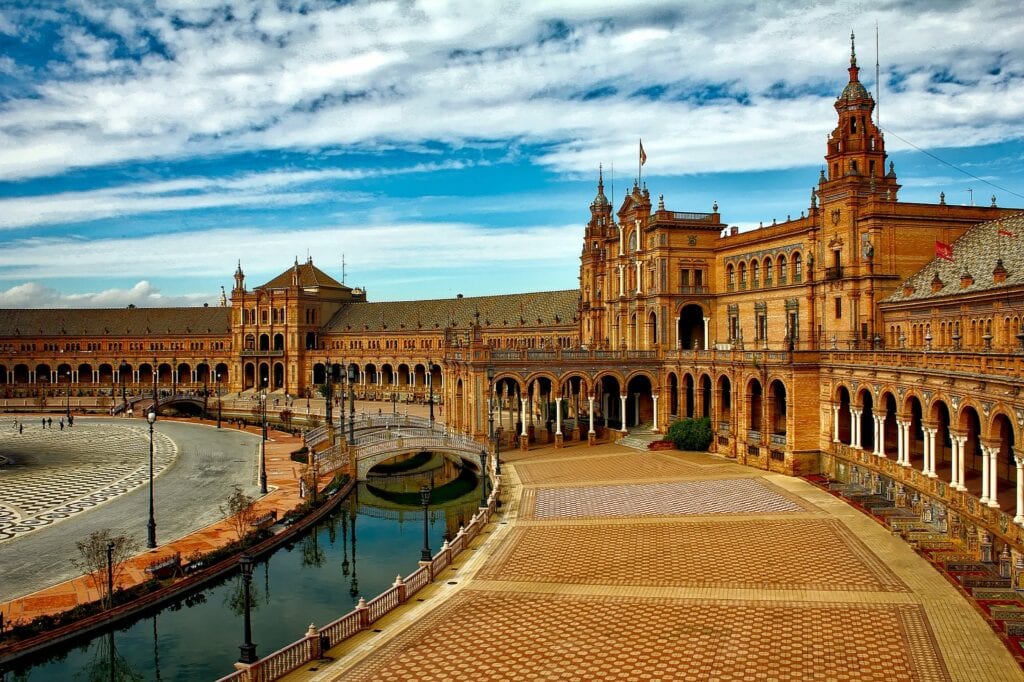
Parque de María Luisa
Just next to the Plaza de España are lush gardens of the Maria Luisa Park which were built after the Ibero-American Exposition. Their main features include beautiful fountains, ponds, palm trees, pavilions and various tropical plants from around the world. The park provides a welcome oasis from the bustling city and is a popular spot for taking a well earned break from sightseeing.
Torre de Oro
On the banks of the River Guadalquivir stands the Torre de Oro which today represents one of Seville’s major landmarks. It was originally built as a watchtower by the Moors who could close access to the harbour by attaching a chain to it and to the opposite bank of the river. It is now used as a maritime museum with exhibits on Seville’s history as a port city.
Hotel Alfonso XIII
This is Seville’s grandest hotel which was constructed by King Alfonso XIII for the Ibero-American Exposition of 1929. Designed in a Moorish Revival style, the hotel has hosted many celebrities and royalty over the decades. It remains one of the most iconic and prestigious hotels in Spain. Non-guests can step inside the building to admire the beautifully decorated entrance areas and dining room and the hotel’s restaurant is open to the public.
Antigua Fábrica de Tabacos
This 18th century former tobacco factory is one of the largest and most impressive buildings in Seville. It was made famous in Bizet’s opera Carmen as the setting where Carmen worked. The large central courtyard surrounded by colonnaded galleries provides a glimpse into the massive size of the former factory where thousands of tobacco workers, especially women, were employed. Nowadays it is home to the University of Seville.
Plaza de Toros de la Real Maestranza
Dating back to 1761, Seville’s 12,000-capacity bullring is one of the oldest and most beautiful arenas in Spain. It continues to host a major bullfighting festival during the city’s Feria de Abril celebrations. There is a popular bullfighting museum at the bullring and visitors can take an informative guided tour of the venue.

Metropol Parasol
This modern mushroom-shaped structure is more commonly known as the ‘Setas de Sevilla’ (setas are mushrooms in Spanish). It consists of six parasols with elevated walkways overlooking Plaza de Encarnación. Underneath are Roman ruins, an open-air market and an archaeological museum.
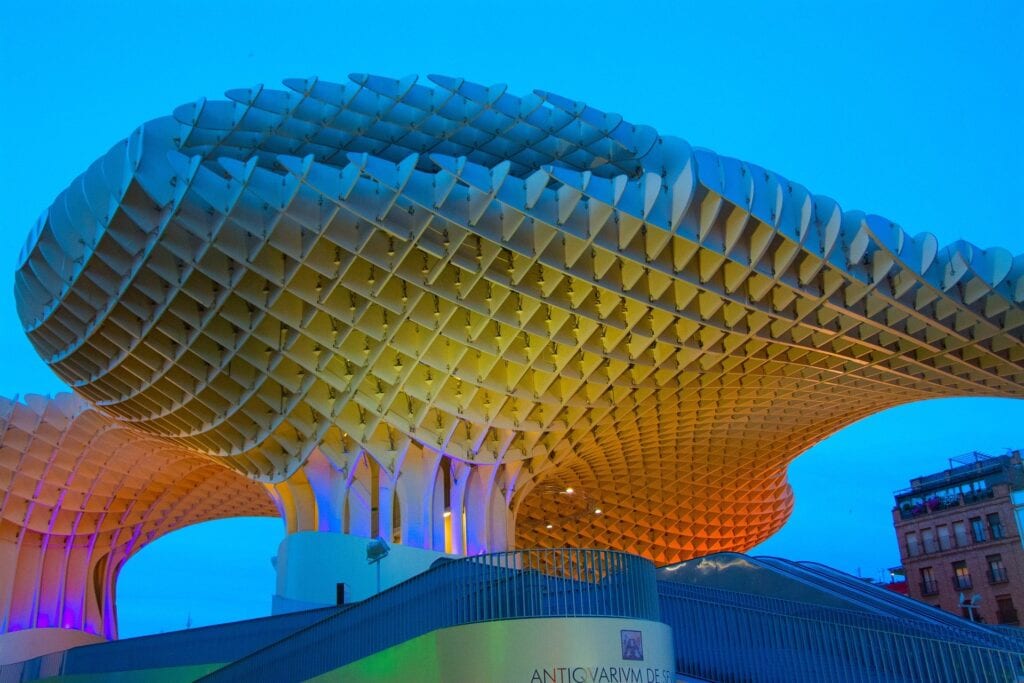
Basílica de la Macarena
The Virgen de la Esperanza Macarena (Virgin of Hope) is Seville’s most loved saint. She is the patron saint of bullfighters and favoured by Spanish gypsies. Her statue stands in the 17th century Baroque-style basilica in the Macarena neighbourhood. This elaborate wooden sculpture, adorned with velvet robes and diamond tears, is carried through the streets of Seville during the Semana Santa processions.
Other magnificent churches to look out for in Seville include the Basílica de Jesús del Gran Poder and the Iglesia del Salvador which are both in the in the San Lorenzo neighbourhood.
La Casa de Pilatos
This 16th century palace imitates a Roman villa and is considered one of the finest examples of Andalusian Renaissance architecture in Spain. The home is filled with art, artifacts and azulejo tiles. The central courtyard has a double arcade with marble columns surrounding a tranquil pond and orange trees. Highlights include the grand staircase, Duke’s Hall with its coffered ceiling and underground ruins of a 1st century Roman temple.
Visit the Best Museums in Seville
Archivo de Indias
This fascinating museum at Plaza del Triunfo near the Cathedral is home to all the documentation related to the discovery of the Americas dating from 1492 to the end of the Spanish Empire in the late 19th century.
Museo de Bellas Artes
Seville’s Fine Arts Museum (Plaza del Museo, 9) is the city’s most impressive art collection. It is housed in a former convent where notable masterpieces by artists of the Seville School (Murillo, Vales Leal and Zurbaran) are well represented.
Museo Arqueologico
The archaeological museum at the southern end of the Maria Luisa Park was built for the Ibero-American Exhibition of 1929. It is one of the city’s best museums with artefacts dating back to prehistoric times. Later exhibits are displayed from the Roman occupation of the Iberian peninsula. Free with EU passport.
Museo de Arte Contemporaneo
This gallery (Santo Tomas, 5) displays a fine collection of contemporary Spanish art from the 1970s to the current day.
Museo de Artes y Costumbres Populares
At this museum of folklore and arts (Plaza de America, 3) there’s an interesting display of costumes worn through the ages at Seville’s festivals and craft exhibitions.
Best Things to Do in Seville
Attend One of Seville’s Festivals
There is always something to celebrate in Seville so whenever you visit you’re likely come across some festivity. The Feria de Abril is the main annual fiesta which coincides with the main events on the Seville bullfighting calendar. Check out the list of festivals in Seville and be sure to book accommodation well in advance as the city gets completely sold out during the April Fair and in Holy Week (Semana Santa).
Go to a Flamenco Show
No trip to Seville is complete without experiencing an authentic flamenco performance at one of the city’s legendary tablaos. As the birthplace of this intricate Spanish dance, Seville offers a range of venues where you can enjoy the complex dance routines, emotional songs and rapid guitar rhythms of live flamenco.
Top tablaos include El Arenal, housed in a 17th century building and hosting shows since 1947. You can dine on traditional Andalusian cuisine while watching spellbinding dancers. Another top venue is Tablao Los Gallos Tablao which hosts high quality performances in an intimate setting every evening. Check out our guide to the best flamenco shows in Seville before deciding on which tablao to go to.
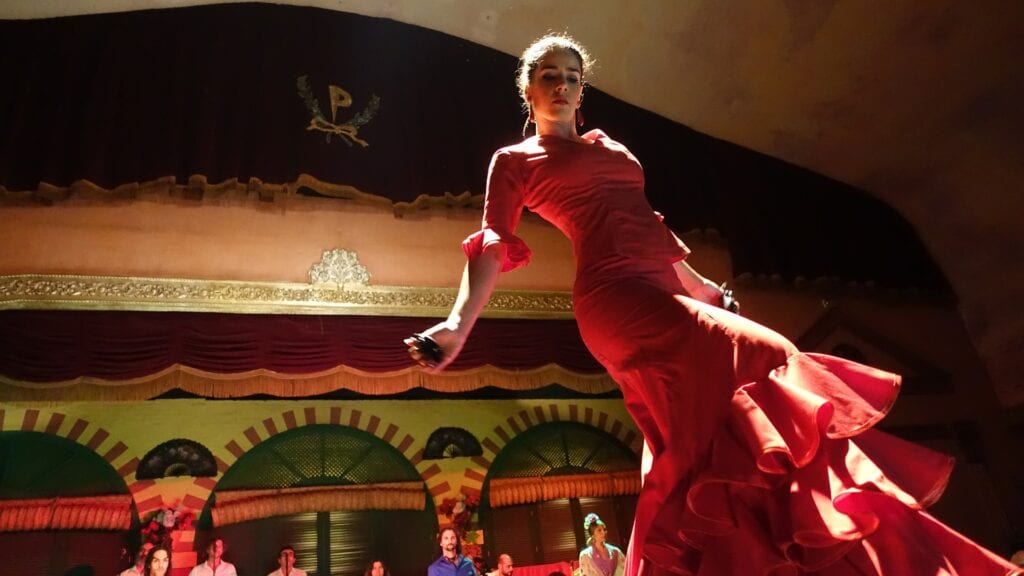
Take a Tour of the Tapas Bars
You can’t leave Seville without indulging in one of Spain’s most beloved traditions – hopping between tapas bars. Typical to Southern Spain, tapas culture entails going from bar to bar sampling small plates of appetizers with drinks. In Seville, going out for tapas is a central part of the social scene. Historic Barrio Santa Cruz is packed with some of the best tapas bars in Seville which are tucked away in its narrow alleyways.
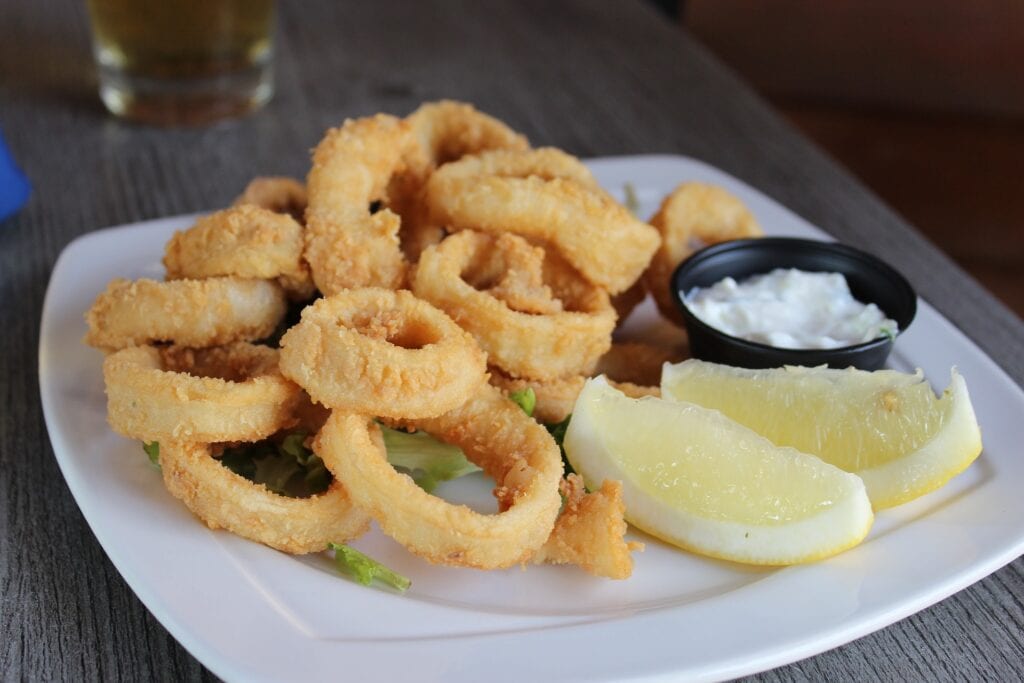
Top picks include Las Teresas, an institution since 1870, and El Rinconcillo which is housed in a former 17th century inn. Wherever you go, make it a point to explore Seville’s tapas landscape. Grazing through the specialties at various bars offers a traditional local experience which allows you to mingle with locals and try local Andalusian delicacies.
Watch a Football Match
Seville is home to two top flight Spanish football teams. The season runs from August to May with home games taking place on alternate weekends. European and cup fixtures take place during the week. Sevilla Fútbol Club is perhaps the better known of the two clubs thanks to their success in the UEFA Europa League. Their city neighbours Real Betis Balompié haven’t enjoyed such success but are one of the best supported teams in the country with a fantastic atmosphere at their home games. Tickets for both teams can usually be bought at their respective stadiums on matchday except for the city derby and matches against FC Barcelona and Real Madrid.
Visit Isla Mágica Theme Park
After the 1992 Expo in Seville this site located on the Isla de Cartuja was converted into a giant amusement park with adjoining business park. It lies just across the river from the northern part of the city providing great fun for children on the many rides which follow a general theme based on the Spanish colonial history.
Take a Day Excursions from Seville
You’ll never be bored in Seville as there are so many things to see and do. However, if you have enough time there are a number of fantastic day trips from Seville to the the great Moorish cities of Córdoba and Granada or to the mountain town of Ronda. The most popular of these excursions is to the nearby town of Jerez de la Frontera where you can watch watch a show of the dancing horses at the Royal Andalusian School of Equestrian Art and take a tour of the the sherry bodegas of Jerez. A shorter excursion from Seville is to the Roman ruins of Italica at Santiponce which is only 8km from the city and easily accessible by bus.
Go Shopping in Seville
Make your way to Plaza Nueva then wander along Calles Sierpes, Tetuán and Velázquez where you’ll find many fashionable locals browsing the upmarket shops. You’ll find excellent women’s clothes and shoe shops as well as top notch bags, jewellery and other fashion accessories on offer. In addition, there are a few specialist shops selling authentic flamenco dresses and accessories (try Calle Francos) as well as a stretch of shops catering for brides to be. There’s also an exceptional selection of shops dedicated to children’s clothes and some ceramic outlets, such as La Ceramica de Sevilla (Calle Garcia de Vinuesa, 16).
Most shops in this area open from 10am until 2pm then usually close for around three hours with afternoon opening hours usually being from 5pm to 8pm. On Saturdays the smaller shops don’t open in the afternoon and everything is closed on Sundays along Calle Sierpes.
For tourist souvenir shopping you’ll find plenty little gift shops selling t-shirts and flamenco items in the streets of Barrio Santa Cruz. Ceramic tiles are also on sale in many of these shops, however, you should head across the river to Triana if you’re interested in buying locally made ceramic items. At Calle Alfareros, 20 you can watch these ceramics being made. Another place to look out for is Ceramica Santa Ana at San Jorge 31 in Triana where there’s a vast selection of ceramic items on display.
For something a little more impersonal head for the enormous El Corte Inglés department stores at Plaza de la Magdalena and Plaza del Duque where you can buy pretty much anything including top quality Spanish food products.
Markets in Seville:
Thursday – There’s a popular flea market on C/Feria near the Alameda de Hércules whose origins can be traced back to the 14th century.
Sunday – You can head over to the Puerta de Triana on Sunday mornings for their weekly market.
Sunday – Also on Sunday mornings there’s a market in Plaza del Cabildo near the Cathedral which sells all kinds of old coins and stamps.
Sunday – In front of the Museo de Bellas Artes in Plaza Museo there’s an art market held on Sunday mornings.
Go Clubbing at Seville’s Nightclubs
Most dedicated Seville nightclubs only open their doors from Thursday to Sunday. They may officially start from around 9pm but you’ll find few party goers before midnight and often the places don’t get really busy until the middle of the night. As long as the clubs are hopping they’ll usually stay open until sometime between 5am and 7am so make sure you get a siesta before going clubbing.
Many of the top nightclubs and discos are in the Triana district, as well as around the Expo ’92 site, but there are also plenty in and around the old city centre. You’ll find that most of these clubs will have strict dress codes. Even when it’s not ‘Feria’ time Sevillanos like to smarten up when they have the chance.
A few popular venues include the following:
- Holiday (Jesus del Gran Poder, 73)
- Birdie (Avda. San Francisco Javier, 24)
- El Coto (Avda. Luis Montoto, 118)
- Culture Club (Cuesta del Rosario, 12)
- Sala Malandar (Avda Torneo, 43)
FAQs About Seville City Breaks
When is the Best Time to Visit Seville?
In summer the weather in Seville is hot, hot, hot particularly in July and August. In these months the streets tend to be empty during the day with people leaving their houses in the early morning and then not leaving them again until late in the evening. This makes for quite a nocturnal life during this time. There is very little rain from June to September.
The winter temperatures tend to be very pleasant and although there can be some rain there are still lots of clear, sunny days. There are lots of terrace bars and restaurants around Seville where people can sit out most months to have a drink and some tapas.
Probably the best months of the year for Spain city breaks to Seville are March, April and May when the weather is good and there are lots of festivals taking place or October and November after the heat of the summer has died down. Really Seville should be avoided in July and August.
Where Should I Stay in Seville?
For first-time visitors to Seville, several areas are recommended for accommodation based on their proximity to major attractions and overall experience. The Santa Cruz neighbourhood, Seville’s historic Jewish quarter, is centrally located and offers easy access to key sites like the Cathedral and Real Alcázar. El Centro, the city’s main commercial district, provides a mix of shopping, dining and historical landmarks.
The Arenal area, near the bullring and the river, offers a blend of history and modern amenities. Triana, across the Guadalquivir River, is known for its authentic local atmosphere and flamenco culture. Alameda de Hércules, slightly north of the centre, is a trendy area with numerous bars and restaurants. El Arenal and Santa Cruz tend to be more expensive due to their prime locations.
Whist all these areas are well-connected by public transport, Santa Cruz and El Centro are the most walkable for sightseeing. It is essential to book accommodations a long time in advance if you’re planning on attending any of Seville’s main festivals such as Semana Santa (Holy Week) and the Feria de Abril. A few hotels we’d recommend are as follows:
Hotel Alfonso XIII (San Fernando, 2)
This hotel was named after the king who commissioned it in 1928 and was designed to be Europe’s most luxurious hotel. It is situated among the arches and arabesques of the historic city centre only minutes from the Reales Alcázares and Plaza de España. It is easy to see why it was named in Condé Nast Traveler’s Gold List.
Casas de la Juderia (Plaza Santa Maria La Blanca)
Located in the Jewish Santa Cruz Quarter, this is one of the most charming hotels in Seville. The hotel comprises a number of houses and former palaces with a quaint patio and fountain at the entrance. Our QUAINT Choice.
Hotel Fernando III (San Jose, 21, Seville)
Great location in the the middle of the Santa Cruz quarter beside the historic Jewish quarter. The hotel is ideal for visiting the main cultural, shopping and tourist areas of the city. The hotel is equipped with a swimming pool on the 4th floor with stunning views of the bell towers and spires of the city.
Hotel San Gil (Parras, 28)
Hotel San Gil is housed in a stunning building in the old quarter of Seville about 200 metres from the Magic Island Thematic Park. Beauiful building and highly recommended but a bit of a stroll to the Cathedral area.
Hotel Becquer (Reyes Catolicos, 4)
A fine choice for location lying just a few minutes walk from the Cathedral and the historical centre. Very helpful staff and easy access by road. They often have special offers making the hotel one of Seville’s best for value.
Silken Al-Andalus Palace Hotel (Avda La Palmera, s/n)
This is a good choice if you don’t mind being about 2½ km north of the city centre. The hotel is in a residential area and overlooks the Betis football stadium and has plenty parking available without having to get lost in Seville’s traffic before finding it. There is a great outside area with a swimming pool and peaceful gardens.
